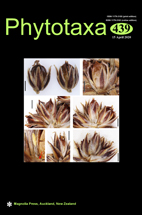Abstract
Peyssonneliaceae represents a monophyletic clade of red encrusting algae classified Peyssonneliales. Molecular analyses have been important for revealing unknown diversity in this family, which includes small, cryptic organisms, frequently distinguished solely by discrete anatomical characters. Brazil however, remains virtually unknown. To assess this diversity, phylogenetic and barcoding analyses using rbcL, COI-5P and SSU data, as well as morpho-anatomical analyses were performed. Here we report the first occurrence of two genera on the Brazilian coast: Ramicrusta and Incendia, and describe three new species: Ramicrusta fujiiana sp. nov., Ramicrusta paradoxa sp. nov. and Incendia yoneshigueana sp. nov. Ramicrusta was resolved as a monophyletic clade in the three reconstructed phylogenies, and had congruent topologies. In the rbcL phylogeny, Ramicrusta fujiiana formed a well-supported clade sister to a well-supported clade including R. aranea (Vanuatu, type locality) and R. textilis (Jamaica, type locality). Morphological characters of R. paradoxa are not in agreement with the original description of the genus. Therefore, we present an updated and broader concept of Ramicrusta. Incendia was resolved as a monophyletic clade with full support for rbcL. Incendia yoneshigueana is in a sister relationship with I. glabra (Vanuatu, type locality). This study extends the distributions of Ramicrusta and Incendia, proposes three new species, and confirms the effectiveness of rbcL, COI-5P and SSU in inferring phylogenetic relationships and delimiting species in the Peyssonneliales. The integrative approach established clear taxonomic concepts for the studied genera and species, and identified useful characters for genera delimitation in Peyssonneliaceae.

